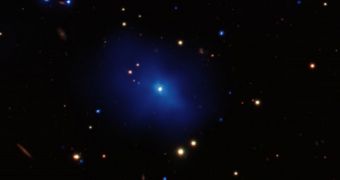Using the NASA Chandra X-ray Observatory, a team of investigators was able to identify a very distant galaxy cluster that features an unusually-cold core. By all estimates, a quasar must be contained within.
The peculiar cosmic structure lies about 8 billion light-years away, which means that it appeared when the Universe was less than half of its current age.
At its very core lies a quasar, or quasi-stellar radio source, which is the highly energetic and active core of a distant galaxy. Among astronomers, these objects are known as the brightest in the Cosmos.
Only supernova explosions can briefly outshine their light, experts say. The objects are also known to be potent radio wave and visible light sources.
What is remarkable about this particular galaxy cluster and its core is the fact that it has been determined to be the farthest such structure in the known Universe. The quasar is called 3C 186.
One of the reasons such structures are so luminous is the fact that usually contain supermassive black holes at their cores, which gobble up such large amounts of matter so quickly, that the energy transfer makes the entire ensemble visible in all wavelengths of the electromagnetic spectrum.
But, while quasars are usually extremely hot objects, this particular one isn't. In fact, it is even colder that the outskirts of the galaxy around it. Its temperature barely reaches 30 million degrees Fahrenheit (16.7 million degrees Celsius).
For comparison, areas in the galactic disk around it can reach up to 80 million degrees Fahrenheit (44.4 million degrees Celsius). Taking quasars in general as a point of reference, that temperature is extremely low, Space reports.
Astrophysicists believe that the core is this cool because of intense X-ray emissions generated by the surrounding gas. As such, this object could be used to study how quasars form and evolve over time.
One of the things astronomers noticed about clusters with cooling cores is that they appear to dwindle in number the farther out into the Universe they look. Most known structures of this type can be found within 6 billion light-years from our planet.
An explanation for this might be the fact that more distant clusters, such as the one containing 3C 186, are more prone to experiencing mergers with other clusters or galaxies.
Needless to say, such events would destroy the cooling cores, by kick-starting black holes back into action, and heating the central regions of the quasars up again.
Additionally, it takes many million years for the quasars to start cooling in the first place, which further contributes to them being very hard to come by.

 14 DAY TRIAL //
14 DAY TRIAL //